In November 2002, more than 80 percent of Oakland voters approved Measure DD, a $198 million dollar bond measure to fund water quality and parks projects throughout the city. Of that, $115 million was allocated for Lake Merritt.
“Our number one goal is to improve water quality and improve habitat in the lake,” said Joel Peter, the city of Oakland’s Measure DD program manager.
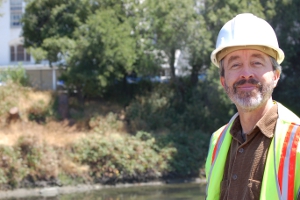 Measure DD Program Manager, Joel Peter (credit: Amy Miller)
Measure DD Program Manager, Joel Peter (credit: Amy Miller)
“The number two goal is to re-establish connections at the lake. In addition to reconnecting the lake and the bay hydrologically, we’re also trying to reconnect people with nature -- because people don’t even realize that the lake’s part of the bay.”
Peter’s task is to oversee more than 50 projects described in the bond. They include restoring creeks and wetlands, improving water quality in Lake Merritt, widening pedestrian and cycling paths and building better roadways to calm traffic around the lake. The project is scheduled to be completed in 2015.
The work on 12th Street is the most extensive piece of the restoration. Crews are reconfiguring the 12-lane road to a six-lane boulevard, lined with trees, a bicycle lane and footpath, all adjacent to a new 4-acre park.
And where an earth-fill dam under the street now restricts the flow of water by forcing it through narrow culverts, a bridge will extend instead, allowing the bay’s tides to flow in and out more freely through a wider channel.
All of this, combined with the other improvements to the area, makes the Measure DD effort what Peter calls “the most wide-ranging and complex series of projects ever undertaken by the City of Oakland.”
Not Really a Lake
Although commonly thought of as a freshwater, man-made lake, Lake Merritt is actually a tidal lagoon that formed after the last ice age where several creeks within the surrounding 4,650-acre watershed empty into San Francisco Bay. The “lake” is connected to San Francisco Bay by a half-mile-long channel, which allows its salty water to rise and fall along with the bay’s tides.
Peter said lack of public awareness about what Lake Merritt really is contributes to the misconception that the lake is actually dirtier than it really is.
“People expect a pristine, clear, Sierra-type lake,” he said. “It’s actually a tidal slough. And if they knew it was salt water and what they are smelling in many cases is just natural things you find around San Francisco Bay in terms of algae growth and mud flats and that sort of thing, actually the water quality in the lake is not terrible before we started this project. But I think that is the perception.”
The heady odor is exactly what Dr. Samuel Merritt smelled in 1854 when the successful San Francisco physician purchased 23 acres around the shoreline of the tidal slough that would later bear his name. Merritt, who became the mayor of Oakland in 1867, was also a shrewd businessman who realized the value of his real estate holdings would increase if the pungent marsh became a recreational lake. So, in 1869, he used his own money to build a dam across the mouth of the slough near where 12th Street is today so that the water level in the lake could be controlled.
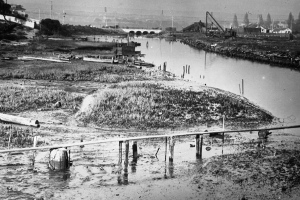 The Lake Merritt Channel in 1908 at low tide (credit: Oakland Public Library)
The Lake Merritt Channel in 1908 at low tide (credit: Oakland Public Library)
The presence of more than a hundred different species of birds including ducks, geese, pelicans, egrets, herons and cormorants also proved to be a great draw for hunters. To alleviate the dangerous gunfire so close to town, in 1870, Merritt was able to persuade the state legislature to designate Lake Merritt as the first state wildlife refuge in North America.
Over the next century, the lake was dredged. Its surrounding marshlands were filled. And the city of Oakland rose up around its 3-mile perimeter. Bit by bit, the channel that connects the lake to San Francisco Bay, which had been up to a quarter mile wide in some places, was filled in.
Today, the channel is an average 110 feet wide -- even narrower where it crosses under 10th and 12th Streets. The steady narrowing has restricted the flow of water in and out of Lake Merritt, which has meant less mixing of the water, and less tidal flushing of the lake, which impacts the health of fish and other aquatic organisms.
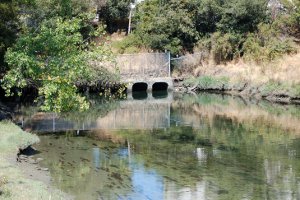 The Lake Merritt Channel today at high tide (credit: Amy Miller)
The Lake Merritt Channel today at high tide (credit: Amy Miller)
But the encroachment of automobiles may have done the most harm.
“The roadways kept getting pushed wider and wider,” said Peter, “and the lake itself and the park around it was less emphasized. And maintenance has fallen off due to budget issues. It became a bit shabby around the edges. People called it ‘the jewel of Oakland’ but felt it had lost its polish.”
Citizens Unite
By 2001, the problems had reached a breaking point. City leaders commissioned a study called the Lake Merritt Master Plan to look at possible solutions. But the plan excluded the problematic south end of the lake.
This exclusion was likely because at the same time, with the backing of then-mayor Jerry Brown, the Oakland Diocese began a campaign to purchase land in front of the historic Henry J. Kaiser Convention Center at the south end of the lake to build a massive cathedral.
With a group of citizens, graphic designer and longtime Oakland resident Naomi Schiff began to organize against more private development on the lake. “Some of us didn’t feel that it was a good idea for Lake Merritt to become a reflecting pond for a church. Any church,” Schiff said.
Schiff, along with a number of architects, community and historical groups, landscape architects and urban planners, founded the Coalition of Advocates for Lake Merritt (CALM). In the process of worrying about the cathedral, the group’s members made sure to be at the table for Lake Merritt Master Plan meetings. They’d done so much research and made so much noise that ultimately, the city asked them to submit a plan of their own for the south end of the lake.
“And so we did,” said Schiff. “And even though we didn’t have any money or source of funding, we cobbled together a proposal which was to narrow 12th Street to six lanes and put in a park.”
CALM member James Vann was one of the architects who worked on the proposal. “CALM felt that that end of the lake could become a destination if we figured out how to address circulation problems and created areas where people could congregate,” said Vann.
After dozens of brainstorming and outreach meetings, CALM came up with a proposal which had the community’s endorsement. “We also put pressure on the city because this was public land and it could not just be given away for private use. There had to be an open and competitive process,” said Vann.
Their proposal was approved.
“Sometimes you feel like you’re David and Goliath and you’re going to lose but somehow, we didn’t lose,” Schiff said. “Ultimately, it was a good thing that the cathedral people came up with this crazy idea because it galvanized all this creative thinking. And it worked”.
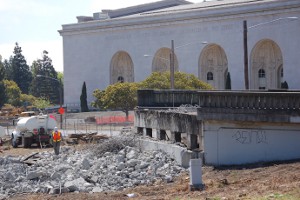 The Kaiser Convention Center and 12th Street demolition at Lake Merritt (credit: Amy Miller)
The Kaiser Convention Center and 12th Street demolition at Lake Merritt (credit: Amy Miller)
Frustrated by years of meetings and plans designed to address the problems at Lake Merritt with few results, Oakland City councilman Danny Wan and his successor, councilwoman Pat Kernighan and others got behind the citizen’s group proposal.
They all convinced Oakland to put a $198 million bond measure on the ballot.
Work Begins, Then Stops
After Measure DD passed in 2002, it took the city two years to complete the designs and coordinate logistics. Actual restoration work on Lake Merritt finally started in 2004.
One of the first jobs was to address the lake’s water quality, which “is better now than it has been, especially if you go way back to 120 years ago when the raw sewage came in,” said Richard Bailey, executive director of the Lake Merritt Institute, a non-profit organization contracted by the city to remove floating trash from the lake several times a week.
But the lake is listed as “impaired” under the federal Clean Water Act for trash and low oxygen levels, Bailey said.
“We also have high bacteria levels but we’re not listed for that,” added Bailey.
There are 62 storm drain outfalls that flow directly into Lake Merritt.
“The biggest problem with the lake is not litter, it’s not oxygen, its ignorance,” Bailey said. “People don’t realize that storm drains go directly to public water.”
Bailey and his group of volunteers remove between 1,000 and 5,000 pounds of trash from the lake per month, depending on the season.
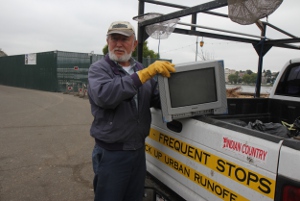 Richard Bailey of the Lake Merritt Institute removes all kinds of trash from the lake (credit: Josh Cassidy)
Richard Bailey of the Lake Merritt Institute removes all kinds of trash from the lake (credit: Josh Cassidy)
To address the trash problem in the lake, Measure DD has funded the construction of four trash collection units on large storm drain lines to intercept and capture floatable debris and sediment before it gets to the lake.
In another project to improve the lake’s water quality, the Lake Merritt Institute installed three aeration fountains and Measure DD funds repaired one existing fountain around the lake to help reduce the stagnant water in some places. But each of the fountains only treats one acre of water. Lake Merritt covers 140 acres.
Planners are hopeful that the lack of dissolved oxygen in the lake will be alleviated after the completion of another key feature of the project: $27 million to improve the Lake Merritt Channel. Construction will involve removal of the culverts at 12th and 10th Streets that have restricted access for people and water between the lake and the channel for more than 100 years.
“The volume of water exchanged at every tide will be double what it is now,” Peter said. “We’re also creating a new tidal marsh by taking out some of the filled land and grading it very carefully down to the sea level and putting in tidal marsh plants to reestablish some of that original habitat.”
New pedestrian and bike trails will be built to pass beneath a new bridge on 10th Street to connect the 12th Street area with the Channel Park to the west. Funds will also go toward improving Channel Park, which teems with birds and fish yet, is virtually unused because of lack of access from Lake Merritt.
Work on the Lake Merritt channel improvements is scheduled to start early next year.
After getting off to what was perceived by many as a slow start, most of the restoration work around the lake has been moving along as scheduled. But in 2006, parts of the project hit a temporary road block when a group of residents called, “Friends of the Lake,” filed a lawsuit to prevent the city from cutting down dozens of trees around the lake to accommodate the new construction.
In late 2007, after an environmental review determined that the trees could be removed without negatively impacting the ecosystem, the lawsuit was dismissed and work resumed.
Budget issues were also responsible for some delays. At a cost of nearly $54 million, the 12th Street project is by far the most expensive part of the plan. When it was originally bid out in 2005, the construction industry in the Bay Area was booming. The city only received one bid, said Peter, and it was significantly over budget. They had to find another way to raise more money.
It took a couple of years for Peter to make up a funding shortfall with matching grants from agencies such as the Federal Highway Bridge Program and the California Coastal Conservancy. During that time, the recession was hitting and construction bids became much more competitive. Peter had his choice of seven bids, all well within the original budget for the project.
“We had the incredible fortune that Measure DD passed when people were really flush and now we’re spending it when construction costs are low,” said Schiff.
The 12th Street project broke ground on May 6, 2010. It will transform south end of the lake by reconfiguring what was a dangerous and inaccessible 12-lane expressway at the edge of a lake into a 6-lane, tree-lined boulevard with signalized intersections and crosswalks.
The redesign will also create new parkland at the edge of the lake and remove unsafe and unsightly tunnels which have been locked and gated by the city since the early 1990’s.
The work on 12th Street will also establish direct pedestrian, bicycle and boat access from Lake Merritt to Channel Park -- setting the stage for what will one day be a direct route from the lake all the way out to the bay.
Lake Merritt’s Road Diet
Many of the Measure DD projects already have been completed. A major part of the renovation involved reducing 4-lane roadways around the lake to two lanes, putting the lake’s major thoroughfares on what is in essence a “road diet” by reducing the number of traffic lanes in order to improve traffic flow. The concept is counterintuitive, planners say, but after running computer simulations of all the traffic around the lake, they figured out how to make it work with better-designed systems.
Two of the affected roadways are Lakeshore Avenue along the southwest side and Lakeside Drive on the southeast. Lakeshore was once a high-speed commute route. By November 2009, it had been reduced to two lanes and bicycle lanes were added in each direction. Better pedestrian crossings, and a 2-way left turn lane in the middle keeps the traffic flowing.
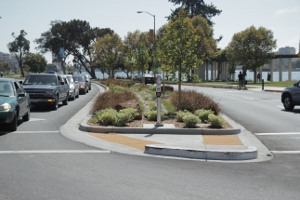 Lakeshore Avenue after going on a "road diet"; Bioswale within the median island (credit: Josh Cassidy)
Lakeshore Avenue after going on a "road diet"; Bioswale within the median island (credit: Josh Cassidy)
Many of the historic buildings and structures around the lake already have received major upgrades with Measure DD funds. The Municipal Boathouse was completely renovated to LEED Gold certification, a top green building standard. It now houses the Lake Chalet restaurant on the top floor and public boating facilities on the bottom level.
Similarly, crews rebuilt the East 18th Street Pier and renovated the Pergola and Colonnade, a scenic row of roofed columns built in 1913 that mark the end of the eastern arm of the lake.
Lake Merritt’s beloved Children’s Fairyland received $3.1 million to build a new Children’s Theater and an addition to the Puppet Theater, which holds the distinction of being the oldest professional puppet theater in the United States.
And at several points around the lake, storm drain outlets were redirected so that water from the paved surfaces runs through a bioswale: a gently sloping trough of tall grasses, filtering the runoff through their root structures and a special permeable soil before it goes into the lake. Trails and bike paths also have been widened and repaved with long-lasting, sustainable materials.
Pride But Concern About Upkeep
On a recent sunny August afternoon, Melissa McDonald and Serena Speth, both from Oakland, were sitting on the lake’s edge with their toddlers.
“It’s fantastic, I love it!” McDonald said. “The pathways and the landscaping are so much better and it’s cleaned up a lot. It’s easier to convince people who don’t live in Oakland to come to the lake now.”
Retired Oakland natives Joseph Hardy and Anthony Lefall walk around the lake every day together from 8AM to noon.
“Everybody’s talking about it and it’s all positive from the citizens that frequent the lake, the taxpayers,” said Lefall.
![]() Oakland natives Joseph Hardy (left) and Anthony Lefall walk around Lake Merritt every morning (credit: Amy Miller)
Oakland natives Joseph Hardy (left) and Anthony Lefall walk around Lake Merritt every morning (credit: Amy Miller)
But both said they are concerned about what might happen in the years ahead.
“After they do all this remodeling, it’s the upkeep,” said Hardy. “These potholes, the birds using the bathroom all over the grass where you can’t lay and enjoy it. This graffiti, if you look all these containers all over the place. Why can’t they have someone maintain it? Maintenance, that’s what we’re concerned about. Maintenance.”
Naomi Schiff echoes their concerns. As part of the Measure DD Community Coalition, CALM’s next task is to try to find the funding to ensure that Lake Merritt continues to thrive and shine.
“I see that as the big challenge,” she said. “And the drawback is that we’re going to have to find money and there is never any government money for non-capital improvements.”
Overall, Measure DD will be a big win for Lake Merritt and the passionate residents who call it their own. Architect James Vann said he is looking forward to Lake Merritt finally living up to its potential.
“With the expanded new pedestrian facilities, family facilities that are coming online that it will become truly the gem of Oakland, Oakland’s jewel and we’ll see many more uses than are there today. That’s my hope.”
View Lake Merritt in a larger map
Google Map produced by Josh Cassidy
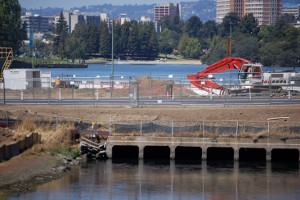 Removal of culverts at 12th Street will increase tidal flow into Lake Merritt (credit: Amy Miller)
Removal of culverts at 12th Street will increase tidal flow into Lake Merritt (credit: Amy Miller)

 The Lake Merritt Channel in 1908 at low tide (credit: Oakland Public Library)
The Lake Merritt Channel in 1908 at low tide (credit: Oakland Public Library)


